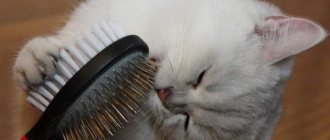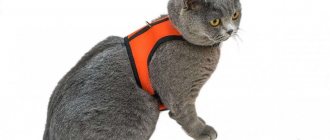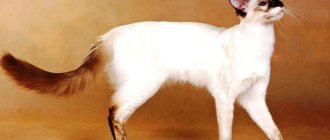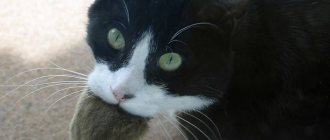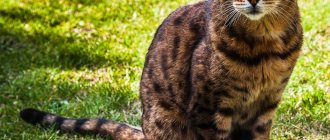People at all times have been touched by one type of cat animal, be it representatives of wild or domestic cats. Moreover, in nature, there are many species of cats that are unusual and amazing in appearance. Here are some of them: May Coon, Caracal, Pallas's Cat, Savannah, Sand Cat, Serval, Serengeti, Chausie, American Wirehair.
We are considering two rare species of wild cats that are on the verge of extinction.
Scientific classification
- Kingdom: Animalia (animals)
- Phylum: Chordata
- Class: Mammalia (mammals)
- Order: Carnivora (predatory)
- Family: Felidae (felines)
- Genus: Caracal (caracals)
- Species: Caracal caracal (caracal)
Buffon in 1761 chose the name "caracal" in connection with the Turkic name for the animal "karrah-kulak" or "kara-kulak", which means a cat with black ears . In Afrikaans (an African language, a dialect of Dutch), this cat is called “rooikat” - “red cat”. Other names for caracal: African lynx, desert or steppe lynx.
Savanna breeding
The owner of a Savannah cat planning to breed should know that all males of the breed of generations F1 - F4 are sterile, that is, incapable of reproduction or infertile. For this reason, Savannah breeding occurs exclusively on the maternal side by mating cats of the F1 - F3 levels with male African Servals.
Males of the F5 level are already quite capable of reproducing, but the purity of the breed does not benefit from this, but quite the opposite, especially since such offspring will no longer correspond to the generally accepted breed standard.
Sexual maturity in Savannahs usually occurs at 7–9 months, but when planning breeding it is better to wait until the cat is 12 months old. It is clear that the cat must be completely healthy and strong in order to bear and give birth to babies without problems.
Mating of this breed should be carried out only under the supervision of specialists from a specialized nursery. According to the rules of most clubs, before mating, a cat is given a so-called “breeding grade” at a show. The rating must be at least “Very Good”. Cats with the title “Breed Champion” and above do not need to visit an exhibition before mating.
It is also important to know that there are not many savanna species in the world yet. For this reason, breeders had no other choice but to cross-breed animals that were essentially close relatives to each other.
This fact, from a genetic point of view, suggests the possibility of many genetic diseases in the breed, but this did not happen. It is difficult to name the reason here; it is possible that the wild blood of the serval did its job.
Today, the highest quality Asher gene pool is offered by the A1 SAVANNAHS nursery in the USA, which was organized by Joyce Sroufe.
There are only four specialized nurseries in the post-Soviet space:
- "Savannah Premium" (St. Petersburg);
- "L'unicorne" (Moscow);
- "Royal Cats", "Luxury Cats" (Kyiv).
Varieties
There are 9 subspecies of caracal:
- West African caracal (Caracal caracal poecilictis) - found in Central and Western Africa, Senegal, Nigeria;
- Indian caracal (Caracal caracal schmitzi) - lives in Western Asia, Iran, Saudi Arabia and India;
- common caracal (Caracal caracal caracal) - found in Central and Southern Africa;
- Gabonese caracal (Caracal caracal lucani) – found in Gabon, Congo, Angola;
- Namibian caracal (Caracal caracal damarensis) – lives in Namibia;
- North African caracal (Caracal caracal algira) – lives in North Africa;
- Nubian caracal (Caracal caracal nubica) - found in Ethiopia and Sudan;
- Transvaal caracal (Caracal caracal limpoensis) - found in Botswana and northern South Africa;
- Turkmen caracal (Caracal caracal michaelis) – lives in Turkmenistan.
Origin
The caracal was originally classified as a lynx, but scientists later discovered that it belongs to a much older lineage that diverged from the ancestral line of cats more than 1 million years before the appearance of the lynx.
Phylogenetic analysis has shown that the Caracal lineage (serval, caracal and African golden cat) diverged from other felids between 8.5 and 5.6 million years ago , when their ancestor arrived in Africa. The serval diverged from the caracal clade about 5.4 million years ago, and the golden cat about 1.9 million years ago. The key to distinguishing these species is a combination of coat pattern and color, body size, ear shape, and tail pattern, color and set.
Breed characteristics
A brief description of the Serval breed was compiled based on expert assessments from the website Usatik.ru and reviews from owners. The indicators are average and may not be suitable for an individual representative. Please note that each cat is individual.
| Character trait | Rating on a five-point scale |
| Attitude towards children | 4 |
| Interaction with strangers | 3 |
| Health | 4,5 |
| Playfulness | 5 |
| Intellectual capabilities | 5 |
| Attachment to home and family | 5 |
| Conflict | |
| Difficult to care for | 1,5 |
| Predisposition to shedding | 0,5 |
| Cost of a kitten | 5 |
| The need for constant contact with others | 3 |
| Aggressiveness | 3 |
| Cleanliness | 4 |
| Dimensions | 5 |
| Picky eating | 3 |
I like2I don't like
Spread range
Geographical distribution
The caracal has a very wide distribution, one of the most extensive of living carnivores, from the southern tip of the African continent, north to the Arabian Peninsula, the Middle East and Turkey, east to central India and further north to Kazakhstan and Turkmenistan.
Photo: Wikipedia
Its historical range has shrunk only on the periphery, where the caracal has suffered significant losses. In North and West Africa in particular, the caracal was exterminated en masse in areas with high rates of livestock land conversion. Experts estimate that it has lost 37.7% of its historical distribution . However, the steppe lynx is most common in South Africa and Namibia, where its range is expanding, possibly due to the extermination by farmers of the black-backed jackal, an enemy of the caracal. In Asia, these felines remain unevenly distributed and are limited to harsh winters, when the Himalayas act as a natural barrier preventing the predator from spreading further north.
Habitat
The caracal occupies a wide variety of landscapes and habitat types at altitudes ranging from sea level to 3,300 meters . However, preference is given to areas at an altitude of less than 1200 meters.
The steppe lynx can be found in arid forests, savannas, scrubland, hilly steppes, arid mountain ranges and on the edges of large sandy areas. Particularly in arid or semi-arid areas, it is most often found in dense vegetation on rocky slopes and in riparian habitats where rodent populations are high.
Photo: Justin Hawthorne
The caracal uses vegetation for cover when hunting and trees for shelter. It sticks to open areas during nocturnal activity and prefers denser thickets and rock crevices during the day. Vegetation offers the predator valuable shade while resting on hot days.
On the African continent, steppe lynxes generally avoid equatorial rainforests and open sandy deserts . In the Asian region, the caracal prefers the drier regions of India, Central and South-West Asia.
Home range
Overall population density depends on prey availability, habitat type, and degree of human persecution. Research shows that the drier the landscape, the fewer individuals it supports. In the semi-arid habitats of Western India there are about 4-5 individuals per 100 sq. km. Throughout South Africa, densities are estimated at 23-47 individuals per 100 sq. km. But in the Beydaglari Mountains in Turkey, only 1.7 individuals per 100 square meters live. km.
Photo: kinou66
Males have a larger home range , partially overlapping the territories of several females. In a well-watered coastal protected area in South Africa, radiotelemetry studies have shown home ranges of adult males to be 31-65 sq. km, and females – 4–31 sq. km.
Reproductive status also influences home range size. When raising cubs, the habitats of females are reduced by an average of 2-2.5 times.
Serval coat hygiene
The serval's coat is quite thick, with a noticeable undercoat, so care for it must be regular and thorough. What you will need to care for a serval's coat:
- slicker,
- furminator for short-haired cats,
- rubber brush,
- a frequent comb or comb made of any material other than plastic.
The serval is groomed every day. The slicker is used once every 3 days, and the furminator - no more than once every 1.5 - 2 weeks. Combing order:
- The wool is smoothed with a comb or comb.
- A slicker brush combs the wool well. Once every 1.5 - 2 weeks, a furminator is used instead of a slicker.
- Then the cat is thoroughly combed with a rubber brush.
- The procedure is completed by combing the hair with a comb or comb.
You should not wash your Serval with shampoo more than once a month. For this, it is best to use a natural cat shampoo with herbal extract or a kitten shampoo, which contains fewer chemicals and is more gentle. Also, servals simply love bathing, so it will be useful to sometimes let him splash around in the bathtub with water. If you have access to a pool or clean body of water, do not deprive your pet of pleasure.
What shampoos are suitable for the Serval:
- Jerob Herbal,
- Perfect Coat Tearless kitten,
- BioGroom Kuddly Kitty,
- K9 Aloe Vera,
- Bio-groom So Gentle.
Photo gallery: shampoos for serval
Jerob Herbal is made from medicinal herbs
Perfect Coat Tearless kitten does not sting the eyes
BioGroom Kuddly Kitty does not contain harsh chemicals
K9 Aloe Vera nourishes and moisturizes the coat
Bio-groom So Gentle does not cause allergies
If your serval spends a lot of time outside, it should be treated with a no-rinse spray shampoo or dry shampoo. The product should be sprayed or poured onto the fur, then combed thoroughly and wiped with a slightly damp cloth.
Dry shampoos and sprays for Serval:
- Jerob Waterless,
- Pet Silk No Rinse,
- Anju Beaute Aisance Non-Rinse Cleaner,
- Pure Paws Dry spray and powder,
- Chris Christensen Dry Breeze.
Photo gallery: dry shampoos for serval
Jerob Waterless gently cares for the coat
Pure Paws Dry spray is effective, but cannot completely replace bathing
Pure Paws Dry must be completely combed out of the coat after use.
Anju Beaute Aisance Non-Rinse Cleancer contains substances that are beneficial for wool
Pet Silk No Rinse spray allows you to clean your cat's fur without bathing
Character traits
Anatomical features
The caracal is a slender, medium-sized cat with a short tail and long ear tufts; no other African felids have distinct ear tufts.
Photo: Chandler Cruttenden
The head is quite angular and pronounced. The eyes are usually bright green or yellow, and sometimes have a blue tint. Large pointed ears reach 80 mm in length, including tufts that are up to 1/2 the length of the ear. It has been suggested that these conspicuous ear tufts play a role in intraspecific communication.
Most individuals have furry paws ; individuals from the Karakum Desert in Turkey have stiff stubble growing under their paws. The relatively large feet with stiff guard hairs on the underside can be useful for moving over soft substrates such as sand, and provide protection from the intense midday heat in drier areas.
Both the front and hind feet of adults have four pads. Powerful hind limbs allow the caracal to jump vertically to a height of over three meters and up to 4.5 meters in length. The front paw has an additional fifth toe, a strong dew claw used for hunting.
Coloring
The body color is a uniform reddish-brown in southern Africa, but can be sandy in Asia and the Arabian Peninsula. The underbelly is cream with orange or brown spots, and the inside of the legs are pale. The eyes are outlined by a distinct dark line that runs from top to bottom along the tear line and down the nose. This is probably a protective device against sunlight . White fur covers the chin, throat, upper lip and area around the eyes.
Intraspecific color variations are insignificant, females are usually lighter. Animals from regions with low rainfall tend to be lighter in color than animals from regions with high rainfall. Melanists (black individuals) have been recorded in Kenya and Uganda.
The guard hairs are 15-30mm long and the thickness of the coating can vary depending on the season, providing effective insulation against extreme temperatures.
Dimensions
The caracal is a medium-sized cat, the length of the head and body is 61-106 cm. The largest individuals live in South Africa, and the smallest in Israel and the Sahara Desert. The hind legs are set slightly higher than the front legs, the shoulder height is about 46 cm. The caracal has a relatively short (18-34 cm) strong tail compared to most cats, it is approximately one third of the body length and hangs straight down. The paws are usually 50-60 mm long and 40-50 mm wide. Weight varies from 5.8 to 22 kg depending on geographical habitat. Adult males can weigh on average 12.7 kg, and females - 10.1 kg.
- Body length: 75-106 cm (males), 61-102 cm (females)
- Tail length: 23-34 cm (males), 19.5-33 cm (females)
- Shoulder height: 40-50 cm
- Body weight: 8-20 kg (males), 6.2-15.9 cm (females)
Ashera - description of the breed
The Asherah cat is the largest breed of cat bred. Their tall and muscular build gives them greater size than their actual weight. Males of F1 hybrids are usually the largest. F1 and F2 hybrids are the largest due to the stronger genetic influence of the African serval ancestor. The size of the breed is highly dependent on generation and gender.
Early generation Ashers can weigh 8kg or more, with the heavier weight usually attributed to castrated F2 or F3 males, although this is not the norm. Due to random factors in the genetics of hybrids, size can vary significantly even within the same litter.
It is a large, sleek and very muscular cat with a thick tail that is carried low. The wild appearance is enhanced by her characteristic dense and luxurious spotted or marbled coat.
The distinctive features of the Ashera are:
- Wide head;
- The rounded, elongated ears are widely spaced and pubescent along the inner edge;
- Oblong-curved body;
- Elongated slender neck;
- Extended legs;
- The round eyes are set wide apart, with a yellowish-golden iris;
- Ears;
- The tail is thick, tapering to a black tip.
Ashera is the largest representative of domestic cats. The tall and slender body looks impressive. The cat can reach a length of one meter and weigh up to 14 kg. Size varies by generation and gender. These cats are calm, curious and active. The breed's intelligence level is high. They love to swim, run outdoors and play games.
Eating habits
Diet
The caracal hunts many species of animals, with the majority of its diet consisting of antelope, birds and small mammals, including hares, jerboas, ground squirrels, hedgehogs, hyraxes, and porcupines. Sometimes predators add insects, reptiles, ostriches, mongooses and foxes to their menu. The caracal's diet is highly dependent on its geographic range and prey availability.
Photo: Justin Ponder
Sometimes the predator will hunt larger prey, including adult gazelles and springboks. The caracal regularly kills prey that is twice or more times its body weight. Conflicts with humans arise primarily from livestock predation, which has been reported throughout the caracal's range, especially in southern Africa. The steppe lynx is considered responsible for 9-35% of predation on small livestock (sheep, goats) and 11% of predation on cattle calves (cows).
Average food consumption is about 1 kg per day . If there is excess food left, the predator may store it in a tree or dense bush for later. Rarely will a caracal feed on carrion. As a hypernutritive animal (feeds primarily on meat), it does not need to consume large amounts of water.
Hunting tactics
The caracal exhibits typical felid hunting behavior, including stalking and attacking with a lethal bite to the back of the neck or throat , depending on the size of the prey. Small to medium-sized prey are killed with a bite to the back of the neck, while larger prey are killed with a bite to the throat.
The caracal is considered the fastest feline of its size and can chase prey over short distances. The desert lynx is known for its exceptional ability to catch birds, jumping high and knocking down several birds at once with its front paws.
Keeping domestic servals and caracals
Domesticated cats, which were raised in special nurseries, are friendly and gentle, however, due to their very large size, it is not recommended to have them for families with children under 5-6 years of age. After all, a pet can seriously scratch if the child is too annoying. Cats can be cautious and even timid with strangers, but they love to play with their owners, fetch a ball, and are able to learn several commands.
These large pets are kept in a private house with an enclosure, as the animal needs active walks. Cohabitation with rodents, parrots, canaries and ferrets is impossible, since the hunting instinct will inevitably make itself felt.
Animals do not require special care. Like all cats, they clean their own fur. To prevent harmful insects from settling on your pet’s body, we recommend drops against fleas and ticks. Since animals consume mainly raw meat and bones, it is necessary to carry out prophylaxis against worms (more about the drugs). For entertainment, you can build a swimming pool in the courtyard of your house. The tray can be ordinary, but larger.
Average life expectancy is 13-18 years. Pets are vaccinated with cat vaccines. (More about cat diseases and types of vaccines in the blog)
Lifestyle
Photo: Christiaan Viljoen
Although the caracal is primarily nocturnal , activity levels are bimodal and dependent on ambient temperature rather than photoperiod. Travel speed usually increases at night. This predator prefers temperatures below 20 °C, and daytime activity increases on cool, cloudy days. Males move 5-15 km daily, and females move 2.5-10 km per day.
The caracal prefers solitude , and only occasionally are the movements of two adults or females accompanied by their offspring observed.
Males exhibit throwing behavior by moving their paws across wet sand after urinating, or mark by raising their tail vertically and spraying urine onto vegetation and logs around their territory. Females also exhibit throwing behavior, although not as frequently as males. Both sexes use "tree scratches" to mark their territories.
Nutrition
In the free wild, the serval feeds on hares, birds and rodents.
Thanks to its long legs, the cat successfully tracks prey in tall grass.
Domestic servals carry hunting instincts in their genes and should not be left unattended with pet birds or rodents.
A complete diet for a domestic serval consists of:
- Raw meat (you can give chicken, beef, rabbit);
- Raw quail eggs (once a week);
- Feeding mice and frogs;
- Vitamins with added calcium.
In parallel with natural food, your pet should be given balanced food.
Until 6 months of age, the serval needs to be fed twice a day, after which once a day is enough. A domestic Serval should not have free access to food.
Pork is contraindicated for servals. Such meat in an animal can provoke infectious bulbar palsy (meningoencephalitis).
Experts advise that from the age of one year on, one day a week should be a fasting day.
Communication
three of these perceptual systems to communicate . It is assumed that the position of the ears is used for intraspecific communication.
When threatened, the caracal slowly approaches the enemy, holding its head below shoulder level, ears turned outward, and tail twitching. At a higher threat level, it holds its mouth open with teeth exposed and ears pinned back, hissing or spitting.
The caracal is known to exhibit a range of vocalizations, including purrs, growls, hisses and meows. Zoologists additionally mention a leopard-like cry that adults sometimes make. Young kittens emit a high-pitched cry, reminiscent of the cry of a Cape sparrow.
Steppe lynxes also interact through urine spraying and scent marking. They have buccal, mental and anal scent glands that allow individuals to mark territories and demonstrate their receptivity.
Reproduction
Breeding season
The caracal is promiscuous , and females often mate with more than one male. Before approaching females, males examine urine spray sites to ensure they are receptive. Males may fight each other for access to receptive females.
Photo: Christiaan Viljoen
Female caracals reach sexual maturity between 7 and 12 months, and males between 9 and 14 months. However, males will most likely not begin to mate until they are 18 to 20 months old, as dominant older males control the best territories. Females probably do not begin to mate until 14 months of age and may remain reproductive until 18 years of age .
After choosing a partner, males and females travel together for 3 or 4 days, copulating several times during this time. Males do not take part in raising the young and sometimes kill young kittens to induce estrus in females.
Females nest in old porcupine burrows, bushes, or rock crevices and line the litter with feathers and hair. There is no specific breeding season, although reproductive activity declines in winter . In addition, the timing of birth may depend on the status of the female and the availability of prey.
Females' estrus cycles last from 1 to 6 days. Usually only one litter is produced each year. The gestation period averages 78-81 days. A litter averages 2-4 kittens, but up to six kittens can be born.
Cubs development
Kittens are born blind, opening their eyes at 6-10 days. At birth, the ears will lie flat on the head and will stand up only after 30 days, when the tufts on the tips of the ears have grown to 10 mm in length.
The cubs begin hunting with their mother 4-6 months later, shortly after weaning, at which time their fangs erupt. Young individuals can leave their native den by 9-10 months or can remain with their mother for up to a year . Males disperse over an area of up to 60-90 km from their natal ranges, while females remain and can occupy home ranges that partially coincide with the ranges of their mother.
Raising wild cats
Patience is especially useful in this matter. A little mustachioed friend is acquired at the age of 2-3 months. The serval and caracal kitten strives to try everything by tooth (like little puppies), so from childhood it needs to be taught the “No/Stop” command.
If the baby does not obey and continues, for example, to chew on wires, after a strict command, direct a stream of spray at him. This should catch you off guard and interrupt the unwanted action.
Don’t let him play with your limbs, otherwise the cat will not give up this fun even after he grows up. In addition, from an early age, get him accustomed to a leash and walks in the yard, because without physical activity he will be uncomfortable.
Save Status
The caracal is listed as "Least Concern" , despite population trends being unknown across much of the steppe lynx's geographic range. They are considered rare or endangered only in Asia and North Africa, and are considered nearly extinct in India.
Although the caracal is protected by law in many countries, its populations are threatened by widespread habitat destruction for agricultural development or road construction, poaching for fur or meat, the trade in exotic animals, and conflicts with farmers.
Did you know?
- The average lifespan of a caracal in the wild is 10 years, but captive specimens can live up to 19 years.
- The caracal was traditionally used as a hunting cat by the royalty of Iran, India, Egypt and Syria. Tamed predators hunted antelope, rabbits, peacocks and pheasants.
- The ancient Egyptians attached a certain religious significance to these felines, mummifying them to guard their tombs.
- The caracal usually does well in captivity. However, its natural instincts, including hunting, high jumping and marking, make it an undesirable pet with high demands on personal space.
- In 1998, a caracat, a hybrid of a caracal and a domestic cat, was born for the first time at the Moscow Zoo.
How to choose a kitten
Today's price for a serval kitten from a good cattery is approximately 10 thousand dollars.
This stops many who want to have such a pet.
At the current exchange rate, the price in rubles exceeds 600,000.
In order for a domestic serval to become your friend, you need to adopt it as a kitten no older than 5 months of age, but not earlier than 1.5 months.
In any case, the younger the kitten, the easier it becomes tame and the faster it becomes attached to its owners.
If you take a completely baby and feed him from a bottle, this, of course, will further strengthen the connection with you initially, but taking such a step is not necessary.
The main thing is to always hand feed him while he is not yet an adult.
This is a psychological trick: the serval gets used to the safety of your presence and begins to respect you.
This is not just a kitten - this is a child who needs your care, affection and attention.
Important! Never press your kitten with your gaze from top to bottom. You need to play with him so that your eyes are on the same level with him. Then he will feel comfortable. Just lie down on the floor next to him and play. Over time, he will feel calm, regardless of your position in space.
Under no circumstances should you hit a serval - this is a sure way to lose his trust.
The serval cat is a very smart animal, so a few explanations or a silent demonstration of his dissatisfaction will be enough for him to understand and realize his “jamb.”
At the same time, the Serval is quite cunning and stubborn.
Advice! Your understanding and forbearance are the main tools in raising servals. Be patient and give them maximum attention, and they will reciprocate.

